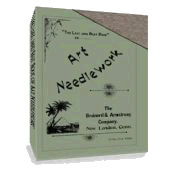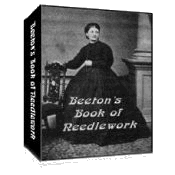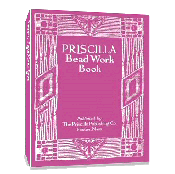Free Hand Embroidery Design
A Beautiful Poppy Design
Here is a wonderful free hand embroidery design that was very popular with Victorian ladies. You’re sure to love it, too.
Instructions for Making the Poppy Design

Click on picture to see more detail.
Probably few flowers are more suitable, and as effective for a sofa cushion as the red poppies shown in our study, and illustrated in the finished cushion below.

Click on picture to see more detail.
These brilliant flowers with their yellowish-green centers, and stamens and dark brown anthers, when worked upon a copper colored plush, and having olive green plush corners sewn diagonally across two opposite corners, and finished with appropriate silk ball fringe and silk pom-poms for the corners, present a harmonious effect that is very pleasing to the eye.
Let us begin by making a perforated pattern. This done, use the French indelible stamping, as described on Victorian Transfer Methods in getting the outlines upon the plush. This process takes a little time to dry, but must be thoroughly dry before working. The material is then placed in an embroidery frame. Now make a careful observation of the full size working design and notice how all the stitches are worked, where the needle is first inserted and where brought out; note carefully the correct slant that is given to the stem stitch, and the chenille stitch seen in the blossom, and how the knot stitch is made and used in putting in the dark anthers of the poppies.
You will require three or four shades of olive green chenille for the stems, leaves and bulbs, and three shades of garnet chenille (poppy tints) for the blossoms and buds: a little yellowish green etching silk for the stamens, a skein of seal brown embroidery silk for the knots with which to put in the anthers, will complete the list of materials.
Begin working the stems with the darkest of the three shades of chenille. Commence working the large stem at the bottom, and bring the needle up at the left-hand side. of the stamped outline; now insert it at the right-hand of the outline and bring it out at the left-hand outline, giving it the upward slant shown by the needle in the partly finished stem.
Work all the stems first, and then begin the leaves, at the bottom of the spray. These leaves are similar in shape to those of the Scotch Thistle , and may be worked in the same way, but with olive green shades or chenille.
We will begin with the large leaf below the blossom. Thread a large wool needle with your medium shade of olive green chenille and begin working the lower half of the leaf, commencing where the leaf joins the stem. Bring the needle up through the material at the vein, then take it down at the edge of the leaf (giving it the slant indicated by the stitches seen in the engraving). Now bring the needle up again at the edge of the leaf, a short distance nearer the point of the leaf. The needle is then taken down at the vein of the leaf, and again brought up at the vein, and so on. The finished leaves seen in the engraving show how far apart the stitches should be. Use a lighter shade for the tips of the leaves.
When this is done, take a darker shade and work the other half of the leaf Those parts in the other finished leaves (shown in the engraving) which are intended to be worked in a lighter shade, are shown lighter in the illustration. The other leaves are worked in the same way, varying the shades in each one. The small leaves near the lop of the spray are worked in the lighter shades; so, also, is the small leaf at the bottom.
We will now direct our attention to the bud near the bottom of the spray. It will be seen, by the engraving, that two short stitches at the point of the bud are darker than the rest. These two stitches are first put in with the darkest shade; of garnet chenille, and then the rest of die bud is worked with the darkest shade of olive green chenille, bringing the green partly over the lower ends of the garnet stitches, thus giving the red portion of the bud the appearance of peeping out from under the green.
The large blossom may now be worked. Begin at the outside edge of the petal, using the lightest shade of garnet chenille. Work two rows of stitches, of unequal length, around the outside edge of the petal, and also one row on each side of the petal where it touches the other petals. Now fill in another row of stitches with the medium shade of chenille, blending the stitches into the lighter shade. The remaining portion near the center is then filled in with the darkest shade being very careful to keep the ends of the stitches, which are near the center of the flower, closer together than the ends of the stitches nearer the outside edge, so that the petals will converge towards the center (see finished petal in the large design). That portion of the petal, which is shown dark in the engraving, indicates the parts that are filled in with the darker shades. The partly finished petal and the one below the finished petal are both worked so as to show a little more light garnet chenille near the outside edges, than the finished petal while the three small petals (which are shaded by the green leaves above them) are worked with the darkest shade almost throughout, with the exception of a very few bright stitches at the outside edge of each.
The small blossom is worked in the same manner, using only the two lighter shades. In the partly blown flower, the inside portion is all worked with the brightest shade of garnet chenille, with the exception of a few stitches of dark near the top, to indicate the shadow caused by the turning over of the petal. The two outside petals are worked throughout with the darkest shade, with but a few bright stitches at the top of the outside upper petal.
Now work the upper bud near the large flower. Fill in the top part with the medium shade of chenille, and. for that the part nearer the bulb use the darkest shade; when this is done, work the bulb (that part of the bud nearer the stem) with the medium shade of olive green chenille, bringing the green chenille up partly on the red portion on the bud.
The bud below this one is worked throughout in olive green, with the exception of two or three stitches of bright garnet chenille at the point. The one above the small blossom shows but one stitch of garnet chenille. Having finished the buds, we will put in the green centers enclosed by the larger circle in each blossom, using the medium shade of olive green chenille, taking the stitches back and forth from the outside circle to the small circle.
This done, thread an ordinary needle with seal brown embroidery silk, and put a large knot in the very small inner circle in each flower. Make smaller knots with the same material for the numerous anthers seen in the engraving, just outside of the larger circle. The knot stitch is illustrated in the Poppy design.
The needle is brought up through the material where the knot is wanted, and the floss is wound twice around the point of the needle; now insert the needle at the point where it came up (pulling the floss slightly with the left hand), and draw it back through the material. The knots, stamens and veins are all put in on top of the chenille. The stamens (thread-like organs) are put in with a yellowish-green etching silk, in single stitches running from the anthers to the center, as shown in the illustration.
The veins are put in with dark veining chenille (embroidery floss will do). The direction of the veins and their distance apart is indicated in the worked leaves and in those in outline in the engraving. Your material is now ready to lie made up. The plush, upon which the flower is worked, is now cut into the shape shown in the engraved Sofa Cushion, and olive green plush is sewed to the two opposite corners, which are shown in the engraved cushion in a lighter tint. Two and a quarter yards of silk ball fringe will be required for trimming, and silk pom-poms for the corners. Fringe and pom-poms of variegated garnet would look pretty.
See below for another free hand embroidery design you may like to try:
How to Embroider the Scotch Thistle
How to Embroider the Dogwood Blossom
Return to top of Free Hand Embroidery Design page.
Return to Special Designs page.
Return to Home page.



 433 pages!
433 pages!

